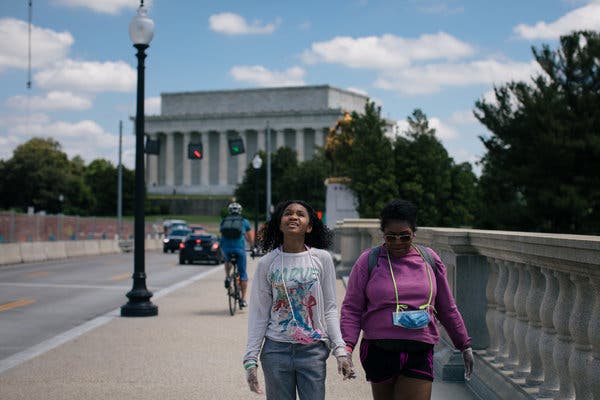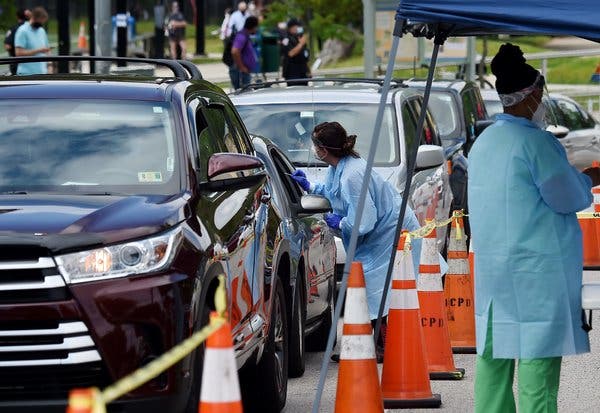Advertisement
Like many areas around the country, Washington and its suburbs are embracing positive momentum in data on infections to push ahead.

WASHINGTON — The leaders around the nation’s capital are pushing forward with plans to reopen the region, hoping they are close enough to their public health goals to move toward normalcy despite coronavirus infection rates that have alarmed federal officials.
“I want to make sure we all understand that moving into Phase 1 means that more people can get infected,” Muriel E. Bowser, Washington’s mayor, said on Wednesday as she announced that parts of the city would begin to reopen on Friday. “It cannot be said enough: Every single one of us has a role to play.”
The northern suburbs of Virginia will also begin limited reopenings on Friday, while suburban counties in Maryland remain shuttered, underscoring the challenges that the region faces with boundaries that its residents crisscross daily.
The Washington metropolitan area, home to 6.2 million people, is among the most interconnected regions in the nation, with a shared public transportation system and entwined economies. The region’s unusual symbiosis is further complicated by the movements of congressional lawmakers in and out of town and a mercurial White House, all posing difficulties for the governors of Maryland and Virginia and the mayor of the District of Columbia — a city that lacks the autonomy of states with the same or smaller populations — as they move to bring their economies back to life.
On Tuesday, in a private call with the nation’s governors, Dr. Deborah L. Birx, the White House coronavirus response coordinator, singled out the Washington region as among a handful of metropolitan areas where positive coronavirus test rates remain above 10 percent. In the call, a recording of which was obtained by The New York Times, Dr. Birx also mentioned Baltimore and Richmond, the largest nearby cities.
On Wednesday, Virginia reported 45 new deaths, the third day in a row of record increases. A majority of them were in the Washington suburbs, where the overall number of infections remains far higher than in the rest of the commonwealth.
Nonetheless, Gov. Ralph Northam, a Democrat, has said that because Northern Virginia health officials judged that the region had met four of the six metrics for reopening, the area would begin to do so on Friday, joining the less-affected parts of the commonwealth. That day, Virginia will also begin a statewide mask requirement for indoor businesses.

The growth rates of new cases and deaths in the District of Columbia have mostly held steady at a time when rates have mostly fallen elsewhere in the country, underscoring the city’s difficulty in fully reversing the course of the virus, as Dr. Birx would like to see.
In Maryland, the two counties bordering Washington have opted to maintain stay-at-home orders as Gov. Larry Hogan, a Republican, has moved to slowly open the state while leaving counties to decide their own path.
On Wednesday, Marc Elrich, the county executive in Montgomery County, a sprawling and diverse suburb across the district line where the most Maryland deaths have occurred, said it would begin restricted reopenings in “a matter of days.”
Another close-in suburb, Prince George’s County — which has nearly 30 percent of Maryland’s cases even though it holds only 15 percent of the state’s population — is expected to take similar measures soon.
A much-celebrated tranche of tests that Mr. Hogan procured from South Korea has not really made its way into the Maryland counties as many local leaders expected, and the counties closest to the nation’s capital — areas with the highest rates of infection and death — have scrambled to obtain their own tests.
“Maryland’s high positive infection rate, one of the highest in the country, shows just how limited our state’s testing capacity is,” said Representative Anthony G. Brown, a Democrat. “We are not testing beyond our sickest residents, leaving us mostly blind to the broader community spread that is likely occurring.”
“Local jurisdictions,” he said, “have been left to fend for themselves to get adequate testing and medical supplies in place. This is a threat to public health.”
Mike Ricci, a spokesman for Mr. Hogan, noted that the governor had said that some components were still needed for the tests, which he got through a contact of his wife, to be used widely around the state. “We have consistently directed much of the state’s response to hardest-hit areas, with Montgomery and Prince George’s receiving the most testing, the most hospitals,” he said.
In Washington, the racial disparities in death rates have been stark.
For instance, Ward 4, a neighborhood with a mix of poor, middle-class and wealthy residents, has more infections — 1,771 total — than any other, largely attributed to workers in so-called essential jobs who take public transportation and often live in dense environments. But there have been only 63 deaths in that area.
In Ward 8, one of the city’s poorest areas, the 1,174 cases are in the middle of infection rates for the city’s eight wards, but the number of deaths, 92, is the highest in the city. The difference, local health care experts said, most likely stems from the fact that Ward 4 is 47 percent black, while Ward 8 is 92 percent black.
The city’s black residents are more likely to be obese and have diabetes, high blood pressure and heart disease, all major risk factors for death with the coronavirus.
“I would add to the resource issue the black population’s historically complex relationship with health care,” said Yesim Sayin Taylor, the executive director of the D.C. Policy Center, a research organization. Ward 8 has far fewer health care resources than the rest of the city, and many residents may be getting tested for the coronavirus at a far later stage than other city residents.
Poverty among black residents in Ward 8 may help explain why their death rates are higher than those of black residents in Prince George’s County, where infection rates are high but deaths lag Montgomery County. Black residents make up about 62 percent of the Prince George’s population, but income levels are higher.
“Wealth allows families to weather an unexpected emergency like Covid-19,” said Danyelle Solomon, the vice president for race and ethnicity policy at the Center for American Progress, a liberal research organization. She noted that in Washington, black residents were 4.5 times more likely to experience poverty than their white counterparts, while in Maryland they were two times more likely.
“It has long been known that only 15 to 20 percent of good health is determined by medical care, and the other 80 percent is determined by the social determinants of health,” said George A. Jones, the chief executive of Bread for the City, which provides food and services for poor residents of Washington. “There is a phenomenon called ‘weathering’ that is used to describe African-Americans’ poor health outcomes.”
Weathering “is caused by the chronic stress of economic and social struggles, which accelerates the rate of health decline,” he said. “Racism in social and economic systems creates a chronic stress that causes worse health outcomes.”


